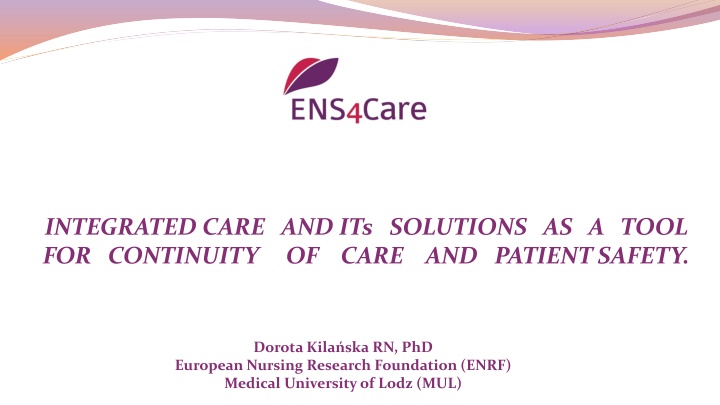
Integrated Care Solutions for Patient Safety and Continuity in Healthcare
Explore the integration of care solutions in healthcare to enhance patient safety, continuity of care, and reduce hospital readmission rates. Learn about the importance of eHealth services in nursing, supported by evidence-based guidelines for quality healthcare systems in Europe.
Download Presentation

Please find below an Image/Link to download the presentation.
The content on the website is provided AS IS for your information and personal use only. It may not be sold, licensed, or shared on other websites without obtaining consent from the author. If you encounter any issues during the download, it is possible that the publisher has removed the file from their server.
You are allowed to download the files provided on this website for personal or commercial use, subject to the condition that they are used lawfully. All files are the property of their respective owners.
The content on the website is provided AS IS for your information and personal use only. It may not be sold, licensed, or shared on other websites without obtaining consent from the author.
E N D
Presentation Transcript
INTEGRATED CARE AND ITs SOLUTIONS AS A TOOL FOR CONTINUITY OF CARE AND PATIENT SAFETY. Dorota Kila ska RN, PhD European Nursing Research Foundation (ENRF) Medical University of Lodz (MUL)
Patient Safety The Council Recommendation on patient safety (Council of the EU, 2009) defines patient safety as freedom, for the patient, from unnecessary harm or potential healthcare. harm associated with
Integrated Care & Hospital Readmission Rates
European Federation of Nurses Associations Evidence Based Guidelines for Nursing and Social Care on eHealth Services The Nurses Voice Thematic Network CIP-ICT-PSP 7 2013
The objective The main objective of the project is the development of evidence based guidelines for the implementation of eHealth services in nursing and social care, building on existing good practices amongst the participants of the Network, sharing and transferring knowledge across the European Economic Area. ENS4Care is the establishment mechanism to support nursing and social care research in the field of ICT enabled integrated care. The ultimate of goal of a sustainable 8
1. Policy-makers in Europe recognise that increased use of ICT in the health and social care sectors can help solve manyof thechallenges. 2. Safe and high-quality care is inextricably linked with the development and implementation of eHealth services. 3. Innovative, high quality, safe and cost-effective national healthcare systems are dependent upon policy-makers and stakeholders developing and implementing high- qualityeHealthservices. 10
Integrated Care is a concept bringing together inputs, delivery, management and organization of services related to diagnosis, treatment, care, rehabilitation and health promotion, integration is a means to improve services in relation to access, quality, user satisfaction and efficiency (WHO). The ultimate goal of ENS4Care is the establishment of a sustainable mechanism to support nursing and social care research in the field of ICTenabled integrated care. 11
Data collection overview Over 100 submissions made Advanced Roles Advanced Roles 14% Prevention 16% Integrated Care Nurse Integrated Care 20% ePrescribing 15% Clinical Practice Nurse ePrescribing Clinical Practice 35% Prevention
The list of equipment used to provide e- services, the results of ENS4Care Project 13
Current status of development 53% 19% 14% 14% Fully Pilot Demonstrator No response Implemented 15
Geographical coverage 52% 24% 19% 5% European National Regional Local 17
Does the practice involve sharing of clinical information 57% 38% 5% NO YES No response 19
Requirements and implications 18 20 14 16 11 12 9 8 8 4 0 22
The practice changed the relationship between departments 76% 80% 60% 40% 19% 20% 5% 0% NO YES No response 24
The practice changed the roles and/or responsibilities of professionals NO YES No response 52% 43% 5% 26
The practice involve sharing of clinical information NO YES No response 57% 38% 5% 28
European integration and policy The practice been part of a European Commission funded project 86% 80% 100% 60% 40% 20% 10% 5% 0% NO YES I don t know/ No response 31
Conclusion There is a prominent role for ICT in supporting the reorganisation of health services towards integrated care and building interoperability forpatient safety. It is important to remember that introducing telehealth and telecare to clinical practice is not about replacing existing services, but instead using technology to enhance, improve access, triage and offer a wider range of choice in the services provided forpatient care. 33
Conclusion ENS4Care sees technology as a support for the needed variation in the way health and social work is organised and delivered in the hope to more effectivelyaddress health inequalities. 34
Conclusion Implementation of eHealth services for clinical practice holds great potential for improving the quality and safety of care for citizens across the EU through ensuring continuity of health care across primary and secondary community sectors. This may yield substantial benefits for citizens and health professionals. 35
Guideline statements eHealth solutions should be considered for any health issue that requires an element of collaboration between primary and secondary health and social care providers. All countries should have a common database-based network solution that can help with the coordination and communication between primary and secondary care providers, including nurses and social workers. ENS4Care General Assembly Brussels, 15 April 2015
Guideline statements Documentation should use the international standards of reference terminology model, which is recommended by the World Health Organisation Consideration should be given to establishing a single point of contact for staff support i.e. a kind of a super-user , who can respond to issues, troubleshoot and offer advice. ENS4Care General Assembly Brussels, 15 April 2015
Recommendations eHealth should not be viewed as a substitute for the face to face contact with professionals that citizens require at times of crisis or during acute phases of their illness, but it has the potential to radically enhance the exchange of information between service users and those concerned with their treatment and support and ensure that new or changing requirements are speedily addressed. 38











